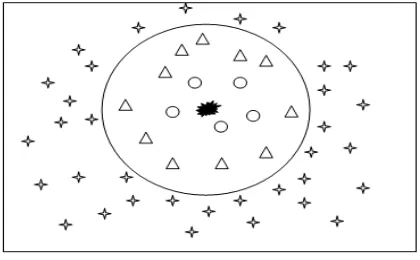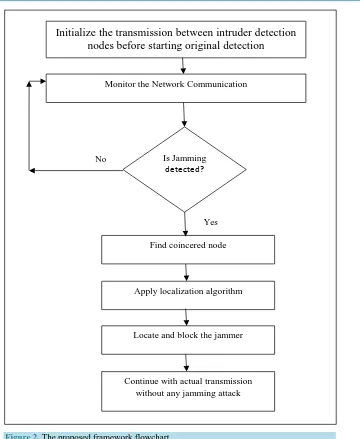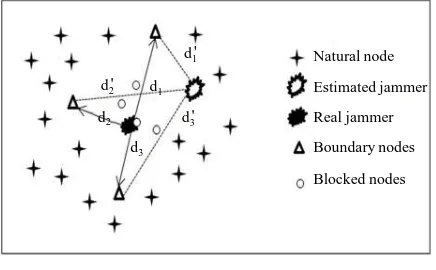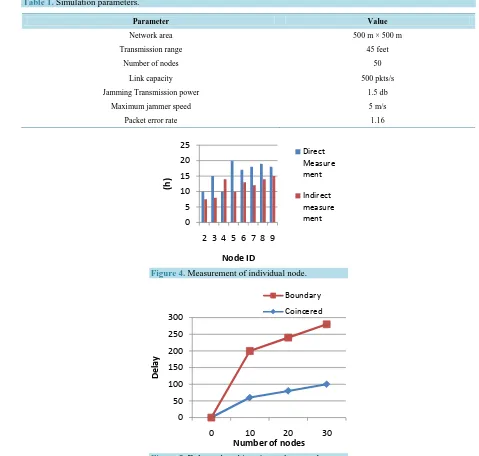http://dx.doi.org/10.4236/cs.2016.79226
A Coincered Node Based Localization of
Jammers in Wireless Sensor Networks
Balamurugan Perumal, Sharmila Vadivel, Mummoorthy Arulappan
K. S. R College of Engineering, Tiruchengode, India
Received 10 March 2016; accepted 5 April 2016; published 28 July 2016
Copyright © 2016 by authors and Scientific Research Publishing Inc.
This work is licensed under the Creative Commons Attribution International License (CC BY). http://creativecommons.org/licenses/by/4.0/
Abstract
Jammers can awfully interfere with the wireless communications. The transmission and reception of wireless communication is blocked by the jammer. The intruder will place the jammer in a well topological network area and they can easily track the information. It will help them to block the signal transmission and reception. Now, the intention is to track the position of the jammer where it is fixed. The existing methods rely on the indirect measurements and the boundary node to find the jammer’s position which degrades the accuracy of the localization. To improve the efficiency, this paper proposed an efficient method namely Coincered Node Based Localization of jammers to find the position of the jammer with high level of accuracy. The proposed system uses the direct measurements, which is the jammer signal strength. The effectiveness can also be increased by using the coincered node that will stumble across the true position of the jammer. The proposed work is compared with existing methods. Then the proposed mechanism proves better to find the jammer location. The simulation results estimate that the accuracy of the localization achieves better performance than the existing schemes.
Keywords
Wireless Sensor Network, Jamming, Jammer Localization, Jammer Signal Strength, Coincered Node
1. Introduction
will intentionally block the area to knock out the signals which has normal transmission and reception. The blocked region nodes cannot communicate with their neighbor nodes and also to the base station. There are dif-ferent types of jammers which could be classified as constant jammers, reactive jammers, deceptive jammers and random jammers.
Constant Jammers: These type of common jammer continually emits the radio signal and never mind wheth-er the channel is idle or not.
Reactive Jammers: This type of jammer stays quiet at the transmission process and starts emitting the signal at the reception process.
Deceptive Jammers: This type of jammers continually emits the valid packets with its header and also not considers the gap between the packets.
Random Jammers: The radio signals alternates between the sleeping and the jammed mode. It stays quiet when the channel is idle.
1.1. Related Works
The problem of detecting jammers was deliberated by Wood et al. [1]. Later, same was deliberated by Xu et al. [2] and they presented some jamming models and discovered the necessity for superior detection algorithms to detect jamming. In the context of sensor networks [3] [4], jamming detection was studied. Also, jamming detec-tion was studied networks involving frequency hopping [5].
Pelechrinis et al. [6] proposed to localize the jamming by measuring packet delivery rate (PDR) and perform-ing gradient decent search. However, they did not present performance evaluation. Liu et al. utilized the network topology changes caused by jamming attacks and estimated the jammer’s position by introducing the concept of virtual forces. The virtual forces are derived from the node states and can guide the estimated location of the jammer towards its true position iteratively. Both jamming localization algorithms are iterative-based, while our algorithm leverages the neighbor changes caused by jamming attacks to localize jammers in one round.
Xu et al. [2] experimented to examine radio interference attacks from both sides of the issue: First, we study the problem of conducting radio interference attacks on wireless networks, and second we examine the critical issue of diagnosing the presence of jamming attacks.
Liu et al. [7] Wireless Networks (WiNet) performed simulation results have shown that the virtual-force itera-tive approach is effecitera-tive in localizing the jammer with high accuracy and outperforms the existing centroid based methods.
Bahl et al. [8] utilized the network topology changes caused by jamming attacks and estimated the jammer’s position by introducing the concept of virtual forces. The virtual forces are derived from the node states and can guide the estimated location of the jammer towards its true position iteratively. Both jamming localization algo-rithms are iterative-based, while our algorithm leverages the neighbor changes caused by jamming attacks to lo-calize jammers in one round.
The presence of jammer in a region will degrade the performance of the wireless networks. So, the localiza-tion of jammer is made at the effective area where the signals can be blocked [1]. The unintenlocaliza-tional interference will enable the signals in a wide range of military strategies.
1.2. Our Contribution
In this work, our goal is to intentionally stumble across the accuracy of jammer localization. The existing loca-lization mostly rely on the PDR values [2], Neighbor aware lists [9], Sending and hearing ranges [7] and calcu-lating the jammer signal strength at boundary nodes [10]. These PDR values [2], Neighbor aware lists [9], Sending and hearing ranges [7] are an indirect measurement that is derived from the affected network topology [11] [12]. The strength of affected nodes is not participated to ensure their own values.
1.3. Organization of the Paper
The remainder section of this paper is organized as follows. We depict the jammed model in Section 2. In sec-tion 3, we proposed a new system and there is an overview of the localizasec-tion algorithm with the subtask of cal-culating coincered node estimation. Furthermore, measuring signal strength is depicted in Section 4. In Section 5, to estimate the true position of the jammer an evaluate feedback metric is calculated. Next, we present the simu-lation and results in Section 6. In Section 7, the paper is concluded finally. The related work is already discussed in Section 1.
2. Effect of Jamming
There are different types of jammer strategies that will disrupt the communications. Here we concentrate on constant jammer which will continually emit the radio signals and block the region whether it is idle or not [1]. These types of jammers will keep disturbing the communication of network.
By using Omni-directional antenna, every jammer has similar range in all other jammed regions. This identi-fication of finding jammers will overcome the existing jamming localization algorithms [2] [6] [7]. The node in the network has been classified based on the disturbance of jammer to the network area. They are the Normal node, Coincered node and the boundary node.
Normal node: These nodes are able to communicate with all other nodes.
Coincered node: These nodes are blocked nodes, where it cannot communicate with all other nodes.
[image:3.595.209.419.577.707.2]Boundary node: These nodes can partially communicate with their neighbors. It can report the measurement to the nodes.
Figure 1 depicts the classification of nodes based on the proximity of the jammer where circles are coincered node, triangles are boundary nodes and stars are the unaffected nodes.
3. The Proposed System
To overcome the weaknesses discussed in above section a novel method is proposed against reactive jamming attack in Wireless Sensor Network. The proposed framework is listed below and also shown in Figure 2.
Step 1: Initialize spare message transmission between intruder detection nodes.
Step 2: Monitor Network Communication for any interruption.
Step 3: Check whether jamming using jamming detection algorithm.
Step 4: Find the coincered node.
Step 5: Then apply localizing algorithm to locate and trap the reactive jammer in the region of duplicate communication.
Step 6: Continue the real transmission without any jamming attack.
3.1. Localization Algorithm
The proposed system has an essential play on coincered node instead of boundary node. So, the steps involved in our localization approach concentrates the procedure on coincered node. A smaller value of the distance indi-cates that the location of the estimated jammer is closer to the true position of the jammer.
Figure 2. The proposed framework flowchart.
The few challenging subtasks involved in the formulation are as follows.
1. Coincerednode ( ) has to set the threshold value using adaptive clear channel assessment.
2. MeasureVal ( ) has to obtain the distance between the nodes to find out the signal strength of jammer. 3. EvaluateVal ( ) is to quantify the accuracy of the location of the estimated jammer position.
Algorithm 1. Jammer Localization Algorithm
No
Yes
Initialize the transmission between intruder detection
nodes before starting original detection
Monitor the Network Communication
Is Jamming detected?
Find coincered node
Apply localization algorithm
Locate and block the jammer
Continue with actual transmission without any jamming attack
This section focuses on the coincered node to measure the distance of nodes to find the signal strength. We delay the discussion of the measureval ( ) to Section 4 and the final evaluateval ( ) to the Section 5.
3.2. Coincered Node
In general, once these nodes are blocked the signals are also blocked. There is no communication between the nodes. It is the nodes that intentionally blocked by the jammer for unintentional radio interference. Since it is affected by jammer, the signal strength of jammer is much better when compared with the boundary node. The jammed nodes are liable to measure the reports by using the clear channel assessment value [7].
The adaptive clear channel assessment is one of the component of the carrier sense multiple access (CSMA) in many wireless networks [7]. In this each network node, either jammed or boundary node is subject to transmit the packets. The threshold value is set for a node once it is jammed the device samples the signal strength of jammer. The sample value is the last report by the jammed node using the threshold value is predetermined. The value from the node is allowed to calculate the distance between the estimated positions of jammer.
Consider the example; if X X1, 2,...Xj the jammed nodes, then each node have to measure the threshold
value once it is jammed. Therefore we obtain the formula for threshold value is given as
{ j| j j, j }
C= X ∀X ∈N X >γ (1)
where C is the coincered node, Xj is the jammed node, Nj is the number of jammed nodes and γ is the
threshold value. The threshold value is set by the adaptive clear channel assessment in the network topology. The value of each coincered node is return to measure the signal strength by finding the distance between the particular node and estimated position of the jammer.
4. Measuring Signal Strength
The signal strength of jammer can be calculated by measuring the distance between each jammed node and es-timated location. The previous existing method uses ambient noise floor which is readily available as commodi-ty devices [11]. The ambient noise floor will sample the values and it is measured at each node. In theoretically, the ambient noise is the signals of unwanted values present always in the network area. The ambient noise floor is the measurement of these ambient noise values. It is yet challenging, the proposed system calculates the dis-tance of all jammed nodes with the estimated position.
Algorithm 2. Acquiring the distance of node approximates the signal strength of jammer
The Algorithm 2 depicts the values must be calculated for all coincered nodes. The mean value of x is re-turn to the evaluate values as the actual parameter d to estimate the true position of jammers.
5. Localization Evaluate Values
In this section, it defines the metric value and the distance calculated for the smallest error value. The first process in the evaluate value is to collect all reports from the coincered nodes. A designated node will gather the x and d values to evaluate the distance. Each jammed node locally reports their values to the designated node. The rough estimation is refined by this evaluate feedback algorithm.
The property of the ey is given as follows, the larger value of ey indicates that the estimation position of
position of jammer. Here we illustrate the property of ey in Figure 2, where there are three jammed nodes are
( 1, 2, 3)j j j values that are away from jammer j.
The distance calculated between the jammed node and the estimated position is denoted as d d d1, 2, 3. After the algorithm evaluates the values of the nodes, the new distance is denoted as d d d1', 2', 3', which indicates that is the distance calculated between the jammed nod and the true position of the jammer. Figure 3 shows the esti-mation of jammer location by the proposed approach.
Algorithm 3. Evaluation of Localizing Jammer
The evaluation of the localizing jammer is given by the values
2
0 1
( )
n
y j i
i
e x x
n =
=
∑
− (2)One of the biggest advantages of this technique is that the difference always makes the estimation error al-ways small. This will indicates that the true position of jammer can be estimated with high level of accuracy.
6. Simulation and Results
6.1. Simulation Environment
The NS-2 simulation environment offer great flexibility in investigating the characteristics of sensor networks because it already contains flexible models for energy constrained wireless networks. This model includes fea-tures for node movements and energy constraint with a wireless sensor network in a square field with various sizes. The nodes are randomly distributed in this area. The simulation parameters are shown in Table 1.
6.2. Results
[image:6.595.206.424.575.710.2]The transmission range of the jammer is fixed at 45 feet. To adjust the density of the sensor network, on one
Figure 3. Estimation of jammer localization. Natural node
Estimated jammer
Real jammer
Boundary nodes
Blocked nodes d3
d3'
d1'
d2' d1
Table 1. Simulation parameters.
Parameter Value
Network area 500 m × 500 m
Transmission range 45 feet
Number of nodes 50
Link capacity 500 pkts/s
Jamming Transmission power 1.5 db
Maximum jammer speed 5 m/s
[image:7.595.64.543.88.544.2]Packet error rate 1.16
Figure 4. Measurement of individual node.
Figure 5. Delay reduced in coincered approach.
hand, varied the total number of the nodes N in simulation environment; on the other hand, extended the area of the sensor network in simulation from 300 feet. Impact of jammer’s transmission range on localization error when N = 200. The impact of node density on localization error when the transmission range is 45 feet is esti-mated. The wireless model essentially consists of the core and the additional simulations features of Ad hoc networks. The node object is a split object. The C++ class node is derived from parent class Node. Therefore a node thus has the basic additional functions of the node from where it is derived.
In Figure 4, the localization of jammer has its high accuracy based on the performance of algorithm under the different network densities and various jammed regions. The multiple network nodes surround the jammer which is at the center of the simulation area. The localization error has a metric value to evaluate the accuracy of the position of jammer.
The Direct Measurement based networking has improves the accuracy of the nodes of 80%. There is better accuracy of localizing the jammer with direct measurement comparing to the indirect measurement.
Figure 5 shows the delay reduced in coincered approach. The accuracy of localizing a jammer with transmission 0
5 10 15 20 25
2 3 4 5 6 7 8 9
(h
)
Node ID
Direct Measure ment Indirect measure ment
0 50 100 150 200 250 300
0 10 20 30
De
la
y
Number of nodes
[image:7.595.214.409.370.539.2]Figure 6. Error analysis of nodes.
range changes from 30 feet, 45 feet to 60 feet. The simulation is run under certain conditions to obtain the better result to localize the true position jammers.
Figure 6 shows the error analysis of nodes and error rate. Error analysis of coincered node is efficient when compared to boundary node analysis. The smallest distance between the estimated location of the jammer and the true location of the impact of jammer’s transmission range is calculated.
7. Conclusion
In this paper, the performance of the direct measurement to detect and localize the jammers in network is im-proved. Our intensive goal is to increase the efficiency by calculating the distance between the coincered nodes and the estimated position of the jammer. The algorithm forms an approximate jammed region, and hence the center of jammed region is treated as the estimated position of jammer. The future enhancement of this paper is to concentrate on localizing the multiple jammers in the network with high level of accuracy for better enrichment.
References
[1] Wood, A.D., Stankovic, J.A. and Son, S.H. (2003) JAM: A Jammed-Area Mapping Service for Sensor Networks. Pro-ceedings of the 24th IEEE International Real-Time Systems Symposium, 286-297.
[2] Xu, W., Trappe, W., Zhang, Y. and Wood, T. (2005) The Feasibility of Launching and Detecting Jamming Attacks in Wireless Networks. Proceedings of ACM MobiHoc, Urbana Champaign,25-27 May 2005, 12 p.
[3] Çakıroğlu, M. and Özcerit, A.T. (2008) Jamming Detection Mechanisms for Wireless Sensor Networks. In: InfoS-cale’08: Proceedings of the 3rd International Conference on Scalable Information Systems, ICST (Institute for Com-puter Sciences, Social-Informatics and Telecommunications Engineering), Brussels, 1-8.
[4] Mraleedharan, R. and Osadciw, L.A. (2006) Jamming Attack Detection and Countermeasures in Wireless Sensor Net-work Using Ant System. Proceedings of the SPIE in Wireless Sensing and Processing, 6248, 62480G.
http://dx.doi.org/10.1117/12.666330
[5] Chiang, J.T. and Hu, Y.-C. (2007) Cross-Layer Jamming Detection and Mitigation in Wireless Broadcast Networks. In:
MobiCom’07: Proceedings of the 13th Annual ACM International Conference on Mobile Computing and Networking, ACM, New York, 346-349. http://dx.doi.org/10.1145/1287853.1287901
[6] Pelechrinis, K., Koutsopoulos, I., Broustis, I. and Krishnamurthy, S.V. (2009) Lightweight Jammer Localization in Wireless Networks: System Design and Implementation. IEEE Global Telecommunications Conference, Honolulu, 30 November 2009-4 December 2009, 1-6.
[7] Liu, Z., Liu, H., Xu, W. and Chen, Y. (2012) Exploiting Jamming-Caused Neighbor Changes for Jammer Localization.
IEEE Transactions on Parallel and Distributed Systems, 23, 547-555. http://dx.doi.org/10.1109/TPDS.2011.154
[8] Bahl, P. and Padmanabhan, V.N. (2000) RADAR: An In-Building RF Based User Location and Tracking System.
Proceedings of the 19th Annual Joint Conference of the IEEE Computer and Communications Societies, 2, 775-784.
[9] Liu, H., Liu, Z., Chen, Y. and Xu, W. (2010) Determining the Position of a Jammer Using a Virtual-Force Iterative Approach. Wireless Networks, 17, 531-547. http://dx.doi.org/10.1007/s11276-010-0295-6
[10] Liu, Z., Liu, H., Xu, W. and Chen, Y. (2014) An Error-Minimizing Framework for Localizing Jammers in Wireless Networks. IEEE Transactions on Parallel and Distributed Systems, 25, 508-517.
0.98 1 1.02 1.04 1.06 1.08
0 20 40
Erro
r ra
te
Coincered Boundary
[11] Liu, H., Liu, Z., Chen, Y. and Xu, W. (2011) Localizing Multiple Jamming Attackers in Wireless Networks. Proceed-ings of the 31st International Conference on Distributed Computing Systems (ICDCS),Minneapolis, 20-24 June 2011, 517-528.
[12] Cheng, T., Li, P. and Zhu, S. (2011) Multi-Jammer Localization in Wireless Sensor Networks. 17th International Con-ference on Computational Intelligence and Security (CIS),Hainan, 3-4 December 2011, 736-740.
Submit or recommend next manuscript to SCIRP and we will provide best service for you:
Accepting pre-submission inquiries through Email, Facebook, LinkedIn, Twitter, etc. A wide selection of journals (inclusive of 9 subjects, more than 200 journals) Providing 24-hour high-quality service
User-friendly online submission system Fair and swift peer-review system
Efficient typesetting and proofreading procedure
Display of the result of downloads and visits, as well as the number of cited articles Maximum dissemination of your research work




